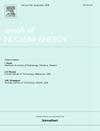Scale model for investigating two-phase flow instability in a PWR passive residual heat removal system
IF 1.9
3区 工程技术
Q1 NUCLEAR SCIENCE & TECHNOLOGY
引用次数: 0
Abstract
To design a scale model of a PWR passive residual heat removal system that preserves and controls the two-phase flow instability, defined as unstable oscillations of the condensate water level at the saturated steam/water interface in the vertical condensate pipe column, non-dimensional (Pi) groups were derived using the top-down (macroscopic) modeling approach known as the Buckingham Pi Theorem. Subsequently, the scaling ratios and scaling laws for the two-phase flow instability-related parameters of the system design—expressed in terms of the ratios of pipe length and diameter between the scale model and the full-size system—were derived based on the relationships between the Pi groups. The scaling ratios obtained for the parameters such as length, diameter, area, volume, time, oscillation frequency, mass flow rate, heat input, and pressure drop were compared with those derived from bottom-up (microscopic/fine structure) modeling approaches, including the three-level and hierarchical two-tiered scaling methods. As a result, the findings of this study align with those obtained using either the three-level or hierarchical two-tiered scaling method, except for the heat input (power) scaling ratio and the power-volume scaling ratio. From a dimensional similarity perspective, the present method appears to yield physically consistent values for the heat input and power-volume scaling ratios, which are defined as the product of the length scaling ratio and the corresponding scaling ratio derived from either the three-level or hierarchical two-tiered scaling method. Consequently, this study makes a significant contribution to engineering literature by demonstrating that the Buckingham Pi Theorem can establish scaling laws for designing a scale model to predict and interpret full-scale system behavior without requiring a comprehensive understanding of transient two-phase flow phenomena, unlike bottom-up approaches that necessitate detailed knowledge of the underlying phenomena.
研究压水堆被动余热排出系统两相流不稳定性的比例模型
为了设计压水堆被动式余热排除系统的比例模型,以保持和控制两相流不稳定性(即垂直冷凝水管柱中饱和蒸汽/水界面处的冷凝水水位的不稳定振荡),采用了自上而下的(宏观)建模方法(即白金汉皮氏定理),推导出非量纲(Pi)组。随后,根据 Pi 组之间的关系,推导出了系统设计中与两相流不稳定性相关的参数的缩放比和缩放定律--以比例模型和全尺寸系统之间管道长度和直径的比率表示。得出的长度、直径、面积、体积、时间、振荡频率、质量流量、热输入和压降等参数的缩放比与自下而上(微观/精细结构)建模方法(包括三级缩放法和分层两级缩放法)得出的缩放比进行了比较。结果发现,除了热输入(功率)缩放比和功率-体积缩放比之外,本研究的结果与采用三级或分层两级缩放法得出的结果一致。从尺寸相似性的角度来看,本方法似乎能得出物理上一致的热输入和功率体积缩放比值,而热输入和功率体积缩放比值的定义是长度缩放比值与三层或分层两级缩放法得出的相应缩放比值的乘积。因此,本研究为工程文献做出了重要贡献,证明了白金汉皮定理可以建立缩放定律,用于设计缩放模型,预测和解释全尺度系统行为,而无需全面了解瞬态两相流现象,这与需要详细了解基本现象的自下而上方法不同。
本文章由计算机程序翻译,如有差异,请以英文原文为准。
求助全文
约1分钟内获得全文
求助全文
来源期刊

Annals of Nuclear Energy
工程技术-核科学技术
CiteScore
4.30
自引率
21.10%
发文量
632
审稿时长
7.3 months
期刊介绍:
Annals of Nuclear Energy provides an international medium for the communication of original research, ideas and developments in all areas of the field of nuclear energy science and technology. Its scope embraces nuclear fuel reserves, fuel cycles and cost, materials, processing, system and component technology (fission only), design and optimization, direct conversion of nuclear energy sources, environmental control, reactor physics, heat transfer and fluid dynamics, structural analysis, fuel management, future developments, nuclear fuel and safety, nuclear aerosol, neutron physics, computer technology (both software and hardware), risk assessment, radioactive waste disposal and reactor thermal hydraulics. Papers submitted to Annals need to demonstrate a clear link to nuclear power generation/nuclear engineering. Papers which deal with pure nuclear physics, pure health physics, imaging, or attenuation and shielding properties of concretes and various geological materials are not within the scope of the journal. Also, papers that deal with policy or economics are not within the scope of the journal.
 求助内容:
求助内容: 应助结果提醒方式:
应助结果提醒方式:


